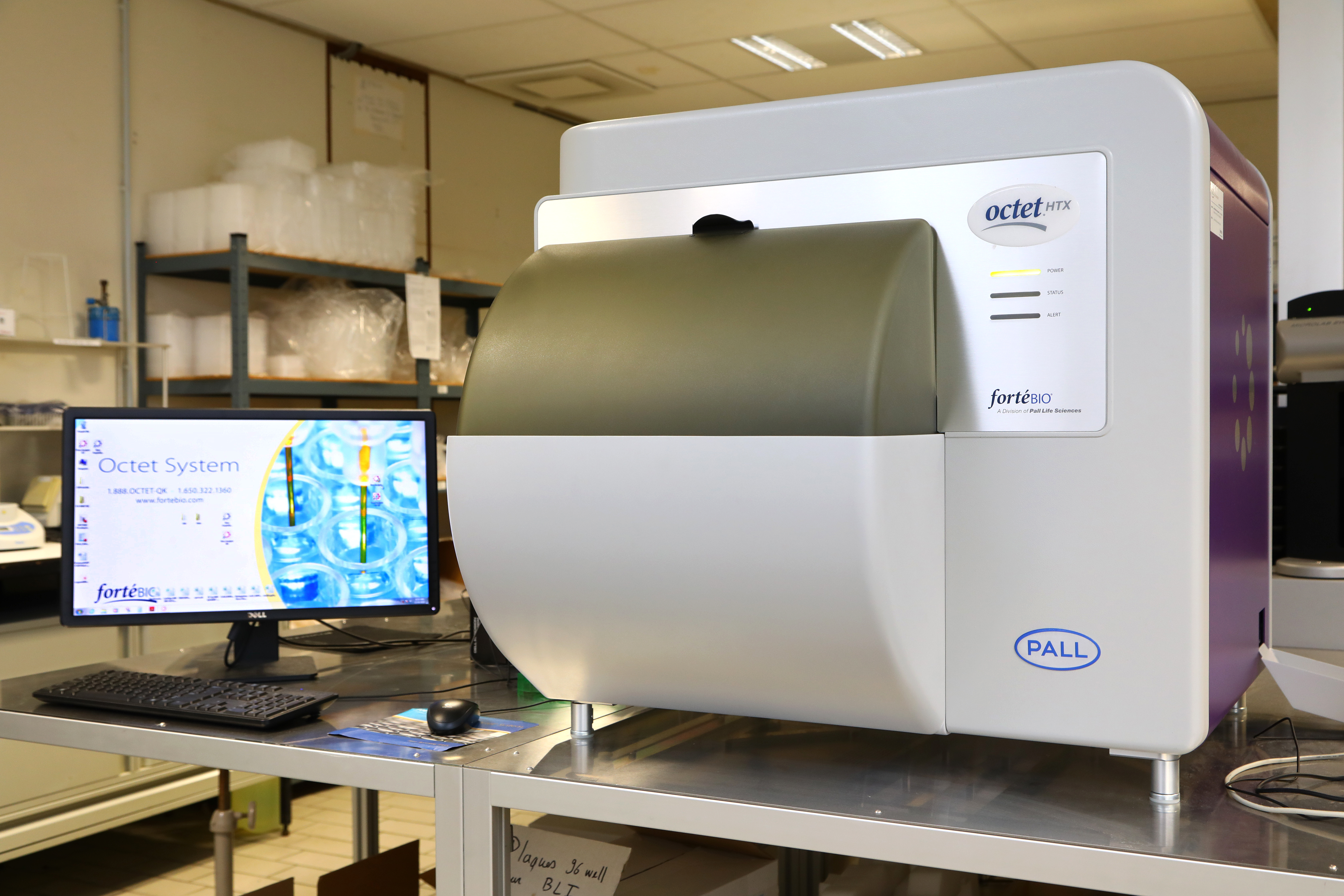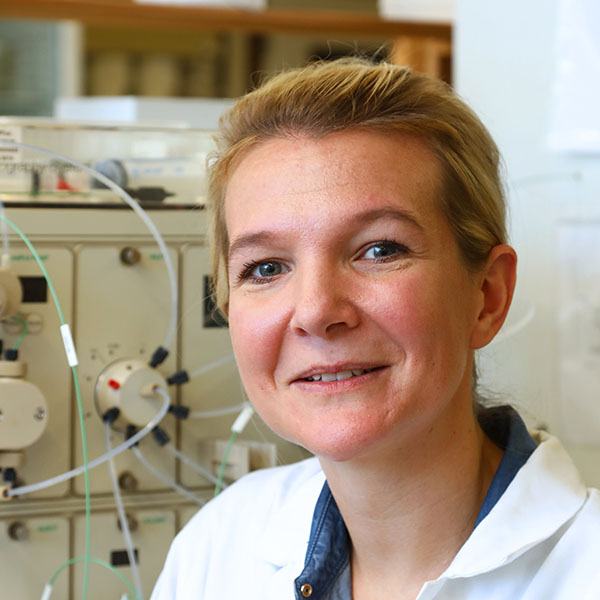The HT Robotein® facility at CIP and SBBC has the particularity to combine high technology laboratory instrumentation: a central liquid handling workstation, a colony picking instrument, various microplate spectrophotometers, an Octet HTX, a LabChip GXII, a protein spotter and an Infrared Imager. This specific combination of equipment offers versatile tools for the development of numerous HT applications. Here is a list of the main services that Robotein® can provide. Nonetheless, we are always open to develop new and innovative assays.
The combination of the central liquid handling platform with the microplate spectrophotometers offers the possibility to analyse in an automated and HT manner the conformational stability (△G0) of proteins in the presence of chaotropic agents (e.g. urea, guanidinium chloride).
Furthermore, a direct link can be created to build a protein array from hundreds of different proteins or proteins that have been submitted to different conditions. A unique combination of a HT protein arrayer (using 96 or 384 –well plates) and a state-of-the-art infrared imager allows hundreds of proteins to be quantitatively analysed in a few minutes for secondary structure, phosphorylation, glycosylation or any contaminant of known infrared spectrum.
The central robotic workstation linked to the Octet HTX instrument (fortéBio), enables real-time and label-free determination of binding affinity (Equilibrium dissociation constant: Kd) by measuring kinetics of association and dissociation of the complex (kon, koff). Using microtiter plates as liquid sample holders, the system can measure up to 96 samples in parallel. The Octet HTX is highly modular and can be easily adapted to measure interactions for a large range of antibodies, proteins, peptides or small molecules.
The combination of the central robotic workstation with the Octet HTX instrument (fortéBio) can also be used to perform fast and accurate protein quantitation from crude extracts (cell extracts, culture media, etc.), with no required purification steps. This method is particularly suitable to measure the concentration of full-length antibodies or various antibody fragments (although the modularity of the Octet system makes it compatible for the quantitation of many other proteins or peptides).
The combination of the central robotic workstation with a microplate spectrophotometer allows for the development of fully automated, easy, fast and robust enzymatic assays. For instance, we have performed automated quantification (i.e. determination of the relevant kinetic parameters: kcat, Km, and kcat/Km) of carbohydrate-isomerases, several dehydrogenases and various β-lactamases.
Using the central robotic workstation together with the microplate spectrophotometer and a quantitative PCR block, we developed protocols for automated screening of 164 buffers/pH conditions to improve protein stability and activity. This screen covers a pH range from 2 to 10, in 19 different buffers that are the most commonly used by pharmaceutical companies. This screen is coupled to HT and automated Differential Scanning Fluorimetry (DSF) thermal shift assays and enzymatic/binding affinity measurements in order to determine the best buffer/pH conditions that are compatible with the protein optimum stability and activity. We have validated this screen with several hydrogenases, oxygenases, ß-lactamases and antibody fragments.
We developed an automated screen of 96 refolding conditions for protein expressed as inclusion bodies. This screen, coupled to HT enzymatic/binding activity measurements, offers the possibility to significantly improve the refolding yield of active protein from inclusion bodies in a fast and reproducible manner.
Our 128×128 focal plane array detector FTIR imaging microscope (Agilent) allows to record 16384 spatially resolved infrared spectra in a few minutes in the mid-IR (4,000-900 cm-1). As such, one image is sufficient to record the spectra of about 100 protein spots produced by the microarrayer. An automatic mapping allows the recording of larger areas. Our dedicated software allows instant computation of protein secondary structure content (an index of protein denaturation) and other parts of the spectra allow the quantification of phosphorylation and glycosylation. Any other molecule can be quantified after proper calibration e.g. lipids, detergents etc.
A system (LabChip GXII, Caliper Life Sciences by Perkin Elmer) for automated electrophoretic separation of nucleic acids (RNA, DNA) and proteins provides a fast and easy way to analyse samples across a wide range of molecule and fragment sizes.
Our Marathon Classic Microarrayer (Arrayjet) is capable of handling six 96- or 384-well microplates for the source and uses an inkjet technology to create an array of proteins on up to 100 slides in one run. Spots can be as small as 50 µm in diameter and are obtained from ca. 100 pl of solution. Spot density can reach 4,000/cm2. The entire system works in a JetMosphere Environmental Control providing HEPA air filtration, temperature control and humidification control.
The Microlab STAR Hamilton workstation is equipped with 8 independent pipetting channels, a CO-RE 96 Probe head and a CO-RE gripping tool for plate displacement. A single position on the deck is mounted with an automated BVS Vacuum System, with pressure monitoring feature. Two Heater Shaker devices are present, together with 10 thermostated positions for 96-well PCR or microtiter plates.
The Octet HTX instrument (fortéBio – Pall Life Sciences) allows HT analysis of biomolecular interactions in 96- and 384-well microplates. It enables real-time determination of binding affinity and kinetics of interactions It can also be used for accurate quantification of protein concentrations from crude mixtures such as cell lysates or hybridoma supernatants. This instrument is highly suitable for screening and characterization of drug candidates and development of possible applications. Up to 96 samples can be analysed in parallel and completed in a relatively short time. Rapid kinetics, epitope binding and epitope binning assays are made possible by the multiplexed biosensor formats.
Two microplate readers (Infinite M200 PRO by Tecan) allow UV/Vis absorbance and fluorescence measurements, together with chemiluminescence detection. One of these instruments is equipped with an injector module, which uses up to two injectors to trigger fast kinetic reactions.
Quartier Agora
Allée du six Août 13
B-4000, Liège
Belgium


